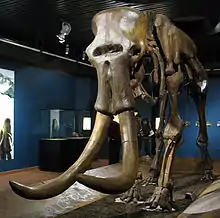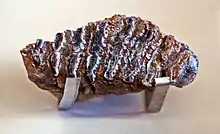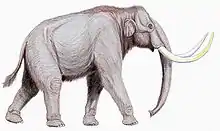Steppe mammoth
The steppe mammoth (Mammuthus trogontherii, sometimes Mammuthus armeniacus) is an extinct species of Elephantidae that ranged over most of northern Eurasia during the late Early and Middle Pleistocene, approximately 1.7 million-200,000 years ago. It evolved in Siberia during the Early Pleistocene from Mammuthus meridionalis. It was the first stage in the evolution of the steppe and tundra elephants and the ancestor of the woolly mammoth and Columbian mammoth of the later Pleistocene. Populations of steppe mammoth may have persisted in northern China and Mongolia as recently as 33,000 years ago.
| Steppe mammoth | |
|---|---|
 | |
| Skeleton | |
| Scientific classification | |
| Kingdom: | Animalia |
| Phylum: | Chordata |
| Class: | Mammalia |
| Order: | Proboscidea |
| Family: | Elephantidae |
| Genus: | †Mammuthus |
| Species: | †M. trogontherii |
| Binomial name | |
| †Mammuthus trogontherii Pohlig, 1885 [1] | |
| Synonyms | |
| |
Taxonomy

There is confusion about the correct scientific name for the steppe mammoth, either Mammuthus armeniacus (Falconer 1857) or Mammuthus trogontherii (Pohlig 1885). Falconer used material from Asian sources while Pohlig worked with fossil remains from Europe and both names appear in scientific publications, adding to the confusion. A first taxonomical overhaul was done by Maglio (1973) who decided that both names were synonyms, armeniacus being the older, hence the preferred name.[2] However, in Shoshani & Tassy (1996) it was decided that the description of Pohlig prevailed, and consequently the correct name for the steppe mammoth is M. trogontherii.[3] It is unclear whether both forms are indeed identical and authors tend to use the name M. trogontherii for European material and M. armeniacus for Asian remains.
Several Japanese mammoth varieties from the early Pleistocene have been named, but all are now thought to be synonyms of M. trogontherii.[4]
Description

The steppe mammoth had a short skull compared to M. meridionalis as well as a smaller jaw. The males had spiral tusks with a recurved tip that could grow as long as 4.9 metres (16 ft) in old bulls; females on the other hand had thinner and slightly curved tusks.
With several individuals reaching 4 m (13.1 ft) tall at the shoulders,[5] it is smaller than the largest proboscideans ever to have lived (Palaeoloxodon namadicus reached 22 tonnes and shoulder heights of 5.2 metres (17.1 ft)), but was larger than other mammoths. A skeleton mounted on the Azov Museum reaches 4.5 m (14.8 ft) at the shoulder, though this figure might be overestimated because the vertebrae have been placed between the tips of the shoulder blades.[6] Another individual represented by a single humerus 1.46 m (4.8 ft) long[7] found in Mosbach Sande, Germany, is estimated to have an in-the-flesh shoulder height of 4.5 m (14.8 ft), weighed between 9–10 metric tons (9.9–11.0 short tons) and might be the largest mammoth found yet.[8] Another estimate gives a shoulder height of 3.89–4.5 m (12.8–14.8 ft) and a weight of 10.4–14.3 metric tons (11.5–15.8 short tons) for the species.[7]
Discovery

Fossilized teeth are recovered, but skeletal parts are rare. The most complete skeleton of a steppe mammoth yet found was discovered in 1996 in Kikinda, Serbia. It was mounted, and put on display in 2005. The specimen is a female, which was about 3.7 metres (12.1 ft) high, 7 metres (23 ft) in length and with 2.7 metres (8.9 ft) long tusks.[9]
Another quite complete steppe mammoth was excavated in the cliffs of West Runton in Norfolk, UK; it preserves its jaws and teeth but is missing the upper part of its skull. A rare skull found in Auvergne, France, in 2008 will be examined by Dick Mol and Frédéric Lacombat in the Musée Crozatier in Le Puy-en-Velay.[10]
In 1959 Zhou, M. Z described what he called a new species of mammoth, M. sungari,[11] that gained recent notoriety as the largest proboscidean due to a 5.3 metres (17.4 ft) tall and 9.1 metres (29.9 ft) long composite skeletal mount based on two individuals found in 1980. However, Wei et al. (2010), who restudied the fossils referred to M sungari, considered this species to be a junior synonym of M. trogontherii. The authors state that some of the fossils are referrable to M. trogontherii, while the others can be referred to M. primigenius, according to morphological characters and measurements.[12]
Evolution
M. trogontherii is derived from Mammuthus meridionalis, the oldest records of the species are known from China, at around 1.8-2 ma in age from the Nihewan Formation near Majuangou, Hebei. Steppe mammoths arrived in North America across Beringia around 1.5 million years ago, giving rise to the columbian mammoth (the ancestor was previously thought to be M. meridionalis but this was due to misinterpretation of tooth wear patterns).[13] Steppe mammoths replaced Mammuthus meridionalis between 1-0.7 million years ago in Europe, in a complex diachronus mosaic pattern. European populations of M. trogontherii experienced a persistent size reduction towards the end of the Middle Pleistocene. A population of M. trogontherii in north east Siberia developed higher tooth plate count after 0.8 mya, reaching M. primigenius morphology by 400,000 years ago. M. primigenius replaced M. trogontherii in Europe around 200 kya.[14] Relict populations of M. trogontherii may have persisted in Mongolia and North China well into the Last Glacial Period, with teeth of M. trogontherii like morphology in Shanxii being dated to 33.858–24.857 ka BP and Inner Mongolia to c. 33.7 ka BP.[15]
References
- Todd, N. E. (January 2010). "New Phylogenetic Analysis of the Family Elephantidae Based on Cranial-Dental Morphology". The Anatomical Record. Wiley-Liss, Inc. 293 (1): 74–90. doi:10.1002/ar.21010. PMID 19937636.
- Maglio, V. J. (1973). "Origin and Evolution of the Elephantidae". Trans Am Philos Soc. 63 (3): 1–149. doi:10.2307/1006229. JSTOR 1006229.
- Shoshani, J.; Tassy, P., eds. (1996). The Proboscidea : Evolution and Palaeoecology of Elephants and Their Relatives. Oxford: Oxford University Press. ISBN 0-19-854652-1.
- van de Greer, Alexandra; Lyras, George; de Vos, John; Dermitzakis, Michael (2011). Evolution of Island Mammals: Adaptation and Extinction of Placental Mammals on Islands (in Danish and English). John Wiley & Sons. p. 240. ISBN 978-1444391282.
- Tikhonov, Alexei; Burlakov, Yuri (2008). "Causes of Northern Giants' Extinction". Science in Russia. Moscow: Nauka (2): 48–53. ISSN 0869-7078. OCLC 28131825.
- Mol, Dick; van den Bergh, Gert D.; de Vos, John (May 17, 1999), "Fossil Proboscideans from The Netherlands, the North Sea and the Oosterschelde Estuary" (PDF), Mammoths and the Mammoth Fauna: Studies of an Extinct Ecosystem, Deinsea, 6, p. 135, retrieved 15 August 2016
- Larramendi, A. (2016). "Shoulder height, body mass and shape of proboscideans" (PDF). Acta Palaeontologica Polonica. 61. doi:10.4202/app.00136.2014.
- Osborn, H. F. (1942). Proboscidea. Vol. II. New York: The American Museum Press. OCLC 505046548.
- Milivojevic, Milos (2011). "Excavation, reconstruction and conservation of steppe elephant from the clay pit of the building material factory "Toza Markovic" at Kikinda (Serbia)" (PDF). Bulletin of the Natural History Museum, 2011, 4: 51-64. Retrieved 23 June 2012.
- Rincon, Paul (2 September 2008). "'Rare' mammoth skull discovered". BBC News. Retrieved 2 September 2008.
- Zhou, M.Z., 1959. Proboscidea. In: Pleistocene mammalian fossils from the northeastern provinces: 22-34, pls. 6-15. Edited by Institute of Vertebrate Paleontology and Paleoanthropology, Chinese Academy of Sciences, China.
- GuangBiao Wei, SongMei Hu, KeFu Yu, YaMei Hou, Xin Li, ChangZhu Jin, Yuan Wang, JianXin Zhao, WenHua Wang; Hu; Yu; Hou; Li; Jin; Wang; Zhao; Wang (2010). "New materials of the steppe mammoth, Mammuthus trogontherii, with discussion on the origin and evolutionary patterns of mammoths". Science China Earth Sciences. 53 (7): 956–963. Bibcode:2010ScChD..53..956W. doi:10.1007/s11430-010-4001-4.CS1 maint: multiple names: authors list (link)
- Lister, A. M.; Sher, A. V. (2015-11-13). "Evolution and dispersal of mammoths across the Northern Hemisphere". Science. 350 (6262): 805–809. Bibcode:2015Sci...350..805L. doi:10.1126/science.aac5660. ISSN 0036-8075. PMID 26564853.
- Lister, Adrian M.; Sher, Andrei V.; van Essen, Hans; Wei, Guangbiao (January 2005). "The pattern and process of mammoth evolution in Eurasia". Quaternary International. 126–128: 49–64. Bibcode:2005QuInt.126...49L. doi:10.1016/j.quaint.2004.04.014. ISSN 1040-6182.
- Wei, GuangBiao; Hu, SongMei; Yu, KeFu; Hou, YaMei; Li, Xin; Jin, ChangZhu; Wang, Yuan; Zhao, JianXin; Wang, WenHua (2010-06-09). "New materials of the steppe mammoth, Mammuthus trogontherii, with discussion on the origin and evolutionary patterns of mammoths". Science China Earth Sciences. 53 (7): 956–963. Bibcode:2010ScChD..53..956W. doi:10.1007/s11430-010-4001-4. ISSN 1674-7313.
Further reading
- Benes, Josef (1979). Prehistoric Animals and Plants. London: Hamlyn. p. 271. ISBN 0-600-30341-1.
- Augusti, Jordi; Anton, Mauricio (2002). Mammoths, Sabertooths and Hominids 65 Million Years of Mammalian Evolution in Europe. Columbia University Press. ISBN 0-231-11640-3.
- Lister, Adrian; Bahn, Paul (1997). Mammuts : Riesen der Eiszeit (in German). Sigmaringen: Thorbecke Verlag. ISBN 3-7995-9050-1.
- Mol, Dick; Lacombat, Frédéric (2010). Mammoths & Mastodons of Haute-Loire. Drukware. p. 271. ISBN 978-2-911794-97-1. (English and French)